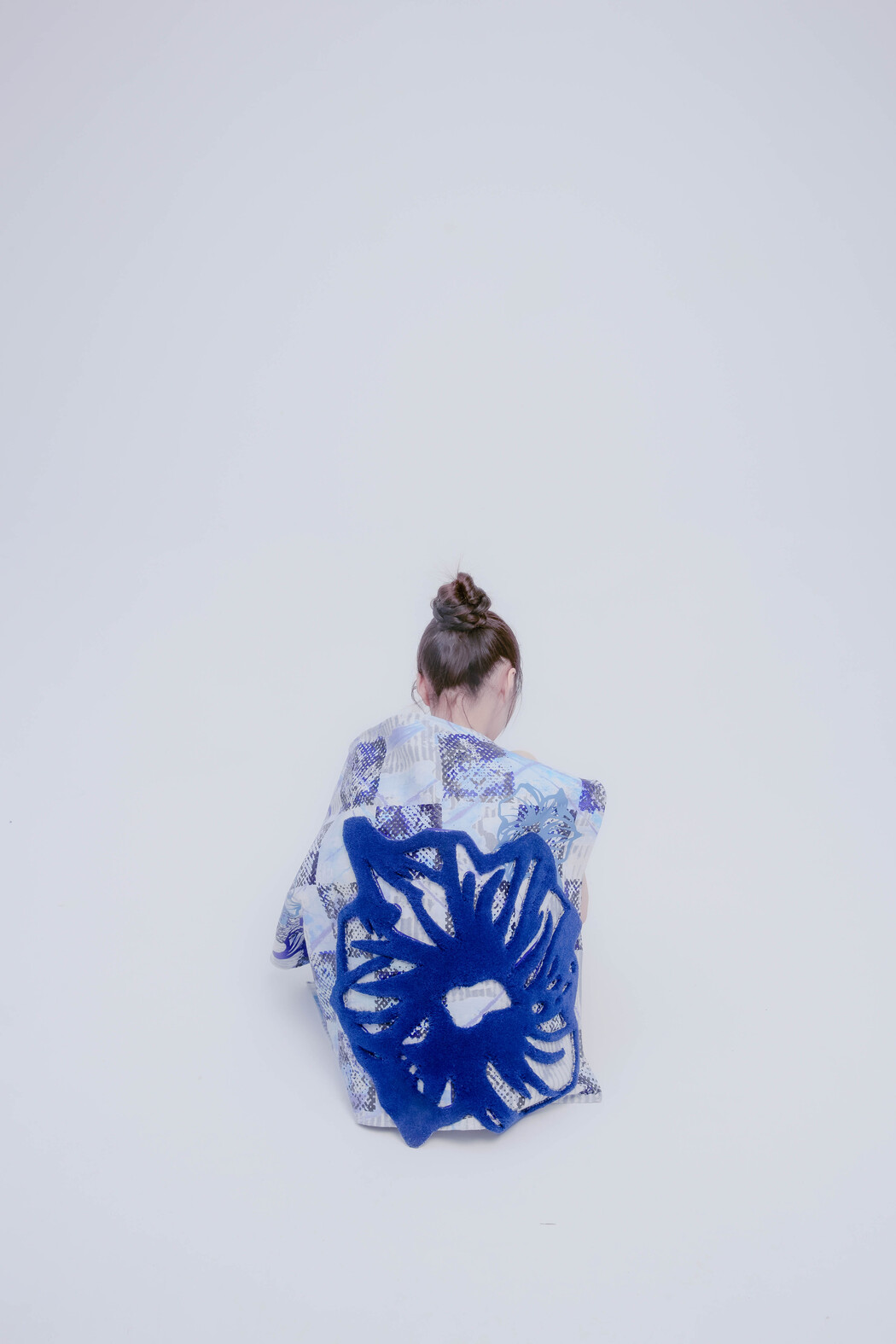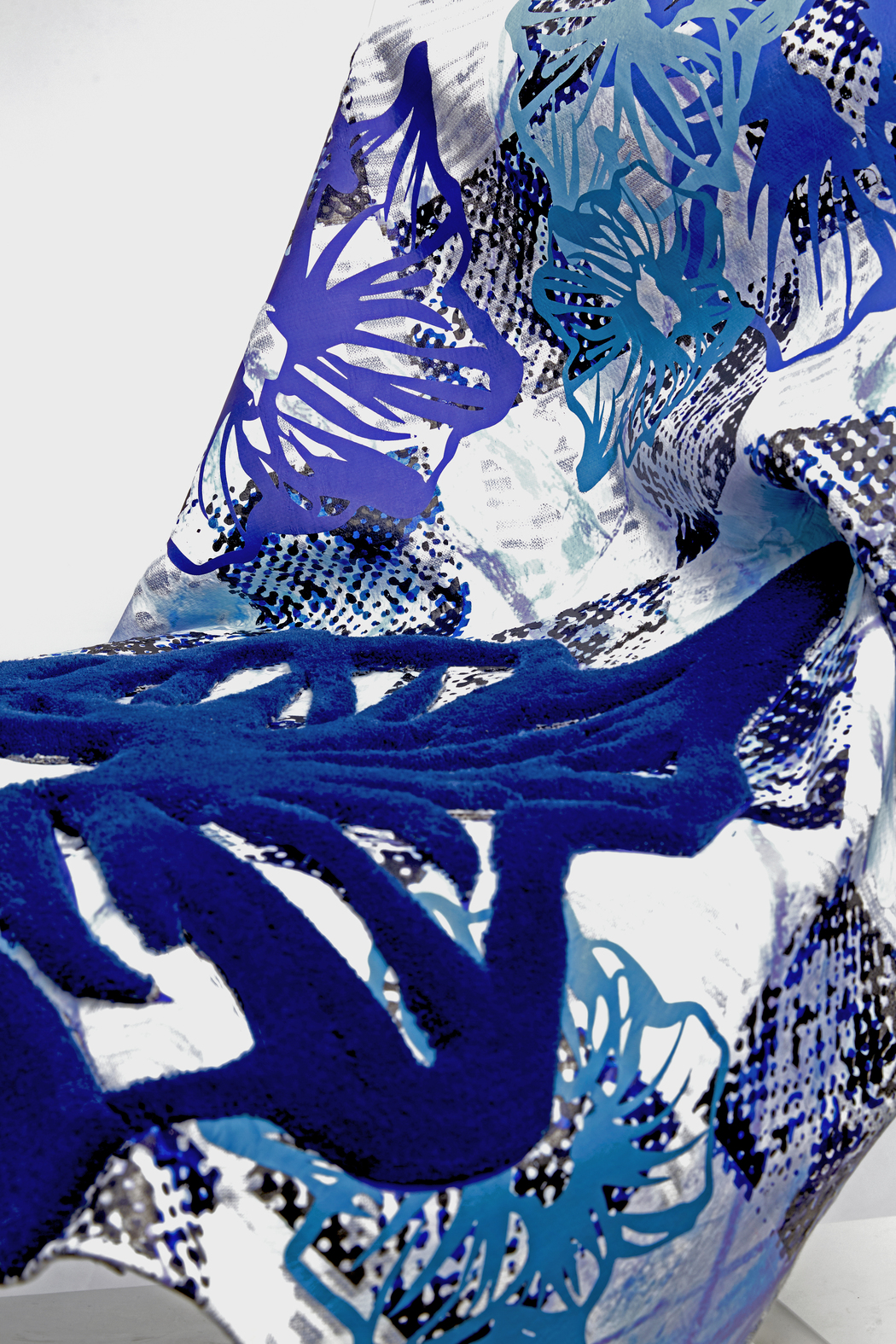Jiaxi Zhang
Where do you live: Between London and Shanghai.
Your education: MFA Communication, Royal College of Art.
Describe your art in three words: Embodied, Relational, Sensorial.
Your discipline: Interdisciplinary visual art across installation, textiles, experimental film, and publication.
Website | Instagram
Your work blurs the line between object and experience. How do you decide which materials best serve the emotional tone of a project?
For me, materials are never just formal tools—they’re emotional instruments. I often begin with a question or a feeling I don’t yet have words for, and the material choice comes from how that feeling wants to be held. Softness, fragility, or resistance—these are not just textures, but emotional tones.
Because my practice is rooted in sensory and embodied experience, I’m drawn to materials that carry affective weight: velvet, conductive yarn, fiber, botanical elements, or even found objects. They speak through temperature, pressure, memory. I often spend time touching, bending, printing, or simply being around materials until I feel something click—when the emotional logic of the piece meets the physical logic of the medium.
In Where’s My Shelter, I used soft circuits, plant-based forms, and interactive textiles connected to Arduino and conductive yarn—not for the sake of technology, but to let grief be both heard and held through contact. I let the materials carry what language couldn’t. That’s often how it works for me: I don’t impose a material; I let it emerge through emotional clarity.
Can you tell us more about how communication theory shapes your artistic process?
Communication theory has shaped how I approach both meaning and audience. I don’t start a project by asking what I want to say—I start by asking how something might be felt, or how presence might be shared without words.
Rather than thinking of art as a message to be delivered, I think of it as a space for relational experience—where attention, slowness, and sensory engagement become ways of communicating. This shift came directly from my study of communication: understanding that meaning isn’t always in the content, but often in the interaction.
In that sense, my practice isn’t centered on delivering fixed messages, but on creating spaces for felt communication. Whether I’m working with textile, installation, or film, I ask how people engage, perceive, and respond—how a work communicates not through explanation, but through atmosphere, proximity, material presence, and the audience’s own movement.
 Jiaxi Zhang | Where’s My Shelter Series | 2022
Jiaxi Zhang | Where’s My Shelter Series | 2022
In your installations and textile works, softness and slowness are recurring themes. What draws you to these concepts, and how do you translate them into physical form?
Softness and slowness are emotional structures in my work, but they are also technical decisions. I often begin with feelings that resist verbal articulation—grief, hesitation, care—and I look for materials that can hold those emotions without overwhelming them. Textiles allow for that. I use tufting techniques and yarn-based materials to create softness—not just visually, but physically. The density, texture, and pile of the surface invite touch and absorb presence, allowing emotional tone to be felt through material weight and depth. Techniques like tufting or flocked printing give the surface a tactile depth, and hand-finishing slows the process down—not just physically, but emotionally.
Slowness also appears in how I shape interaction. I build installations that don’t demand immediate reaction. Instead, they respond to presence—sometimes with subtle sound, sometimes just through material tension. I often use Arduino, sensors, or conductive yarns, but always in quiet ways, where technology supports stillness rather than spectacle. Softness and slowness allow me to make space for what doesn’t need to be explained. Grief, memory, or tenderness aren’t resolved—they’re held, shared, and allowed to linger.
How does living between London and Shanghai influence your approach to themes like care, marginality, or shared presence?
Living between London and Shanghai has expanded both the emotional and methodological scope of my practice. London has given me detachment—a way to observe and reframe familiar questions from a different cultural lens. It has taught me the value of articulation: how to be intentional about presence, care, and context.
Shanghai, on the other hand, grounds me in the tactile, the intuitive, and the socially embedded. It reminds me that intimacy can happen informally—in proximity, in tempo, in collective rhythm. It’s where experimentation often comes with urgency, but also deep instinct.
I think about how to create spaces where difference is not erased, but held. Where presence doesn’t require performance. Where care can happen softly, even in public. This duality isn’t something I resolve—it’s something I live through, and build from. Together, these two places allow me to move between perspectives—between distance and immediacy, clarity and ambiguity. That movement continually informs how I approach themes like marginality and shared presence—not as fixed identities, but as felt relations.
 Jiaxi Zhang | Where’s My Shelter Series | 2022
Jiaxi Zhang | Where’s My Shelter Series | 2022
Many of your projects involve participatory or relational elements. How do you design for intimacy in public or gallery spaces?
For me, intimacy in a public space doesn’t come from grand gestures—it comes from offering people quiet, optional ways to engage. I think a lot about attention: how it’s invited, how it’s held, how it’s respected.
I create spaces that slow people down. To encourage slowness, I work with soft materials and subtle entry points—elements that invite presence without asking for performance. I don’t ask viewers to perform interaction; I build environments that respond to their nearness, their breath, their small decisions. That’s where intimacy begins—not in spectacle, but in permission.
In galleries or public settings, I see intimacy as a form of care. Not control. It’s about creating the conditions where someone might feel safe enough to linger, to feel something, even briefly.
Your wearable publications are especially intriguing. How do you see the body functioning as a site of memory and storytelling?
I don’t see the body as something that wears the work—I see it as part of the work’s language. In my wearable publications, the body becomes a medium of memory and emotion: it holds gesture, tension, and presence. The project I’m referring to was shaped around extraversion—not as loudness, but as spatial behavior. I was curious how extroverted personalities construct visibility: through openness, movement, and the will to be noticed.
So the piece expands outward. Folded structures unfold like social gestures; bold surfaces function as visual volume. The body doesn’t just support the work—it completes it. It becomes part of a shared environment, extending energy rather than broadcasting it. In that sense, the work doesn’t decorate the body, but amplifies its desire to be seen, felt, and mirrored.
My wearable publications let me explore how identity is not only displayed, but narrated—bodily, silently, and relationally. I think of the body as a moving text: something that tells its story through posture, hesitation, rhythm. The storytelling here isn’t verbal—it’s structural, spatial, and sensory.
 Jiaxi Zhang | NEFELIBATA | 2023
Jiaxi Zhang | NEFELIBATA | 2023
What role does failure or unpredictability play in your practice, particularly with tactile or ephemeral materials?
Failure and unpredictability are not setbacks in my work—they’re generative forces. When I work with tactile or time-sensitive materials—like scent, sound, soft fibers, or sensor-based interaction—I invite chance to shape the experience. A tuft might come loose. A scent might fade faster than planned. A sensor may misfire. Each of these moments reveals something: about the material’s own logic, and about how little we truly control.
Instead of correcting these disruptions, I often incorporate them. A delayed sound trigger or an unraveling stitch becomes part of the work’s rhythm. In Where’s My Shelter, these fragile moments mirror the emotional themes—grief, tenderness, impermanence. The unpredictability doesn’t weaken the work; it makes it more alive.
By allowing these fluctuations, I create spaces that feel present rather than fixed. The audience isn’t told what to feel—they’re invited to notice, to stay a little longer, and to find meaning in what shifts, decays, or refuses to settle. In this way, failure isn’t an error—it’s a collaborator.


Leave a Reply